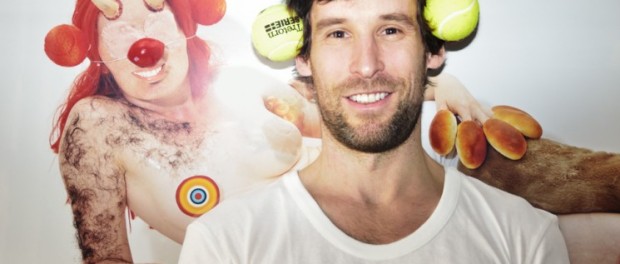Interview with Olaf Breuning: Art Gets Eccentric in All Forms
On September 18, Home 1 by the Swiss-born New York based multidisciplinary artist Olaf Breuning was screened at POP headquarters. The plot navigates between black and white shots of a bumbling madman frolicking in a lavishly kitsch bedroom, and fantastical scenes of his narrated stories. The hero-vagrant, transparent in his dispatch, is charming, uncensored and believable. During the Q&A following the screening, Breuning is asked why this lead character wears bright eye lenses.
Olaf Breuning: Oh, Brian is already a tall skinny redhead. He stands out. I wanted to make him more edgy and strange. In Papua New Guinea we had only one set of contact lenses. Brian said to me, “Olaf I have lost one.” We could not find it, so we put a patch over his eye. It became part of the script as a moment where he had been bitten by a mosquito in the eye.
This answer accurately mirrors the rest of the film. The protagonist (Brian Kerstetter) recollects a baffling visit to Las Vegas, fixating on Venetian gondoliers. He recounts his friend stranded on an island with his girlfriend, “just like in the movies.” The couple live an Adam and Eve scenario, growing matching beards that lengthen with every frame. We witness the narrators visit to the Amish countryside with a gang of friends. He compares their homes to “bleached teeth in the mouth of god.” The gang spot and trip an Amish stroller, releasing him with nothing save for one sock and an ET mask. They pursue the man with golf clubs through the fields. In another chapter he describes his friend bathing in bliss at a ski resort. His friend asks himself (our narrator is both deranged and omniscient) if anything else could possibly exist. No, nothing could possibly exist beyond the perfection of this moment. He then chokes on his glass of champagne, vomiting the words “I Exist.” End scene.
The sequences sprawl into a compilation of unrelated parodies: lip synched music videos by a gaggle of nascent punks eating dog food, bed sheet ghosts terrorizing the public with the aid of a fog machine, the event of being a cowboy once. There is a scene in South America where our hero, dressed in traditional garb of a sheep herder, wrangles cameras from tourists and impersonates traditional practices. The film ends with the recollected-self stepping out of the lineage of the story. He turns to the camera, saying, You think you could do better? The film ends in the banter of the two Brians.
There seems to be no reason for his confession, nor reason to doubt the jargon. Breuning is asked about the violence in certain scenes.
OB: It is highly racist in one way. I think it is on the edge of being too much, and at the time I thought I found a good level. You may see it differently. Violence is a part of our lives. As for the Amish scene, I thought of ET as a cultural parallel of the Amish. I wanted to draw the representations together.
When asked if he was always at ease with humor in a serious context, Breuning reflected on the uses of humor and a steady influx of absurdity.
OB: I never had a problem with it. Humor can be used as an intellectual language. It is not always easy to understand. It is how I feel connected to people. It is also a fine line… The thing is, it is very difficult as the maker to say. Besides, I made this film ten years ago, and each year I try to extend myself otherwise. I could not make this film again.
He explained the theme of the sequel.
OB: Home 2 is about exoticism, and the differences in cultural environment. In Home 2 we have a white man in a non white setting, in Asia, Africa, Tokyo — crowd kidnapping with intention to disrupt normalcy in those cultures. We used this stereotype of the white western visitor. It was just an idea without a script. It was just fun, and uncomplicated by money. I was the camera. In Home 3, we were forced to be amateur as the newly purchased camera i had bought was attracting too much attention about permits. That was in New York
Breuning was trained in photography, has produced film, made public sculpture, did installations, published books of drawings, and worked in collaborations. He even designed a restaurant. He remarked that no medium prevails where art connects each thing. As a diverse presence in the art world, he has these remarks to shed on the industry:
OB: Well no, I don’t believe in the high and low dichotomy. Art is both. The divide is part of a fake world, a fake culture. (Stray applause from audience.) The art world is a small island of creative people. I call myself an artist because I can express myself in a selfish way, to ask why I am here and why I exist. The world is a colorful place. But when I see a stick on the wall with some fabric hanging, I ask, is that really all you got? Someone could write a five page criticism and make me look like an idiot. I am against the island, and the perception that art has to be elitist. We don’t see new things because art students get taught the same things again and again and again. And the academic approach is just one way to do it. Unfortunately or not, I am in the art world – it makes me nervous. But rather than for a small group of scholars, I would rather produce for as many people as possible.
Watch home 1 via Breuning’s tumbler . Olaf Breuning was in Montreal as part of the POP Montreal festival 2015.






